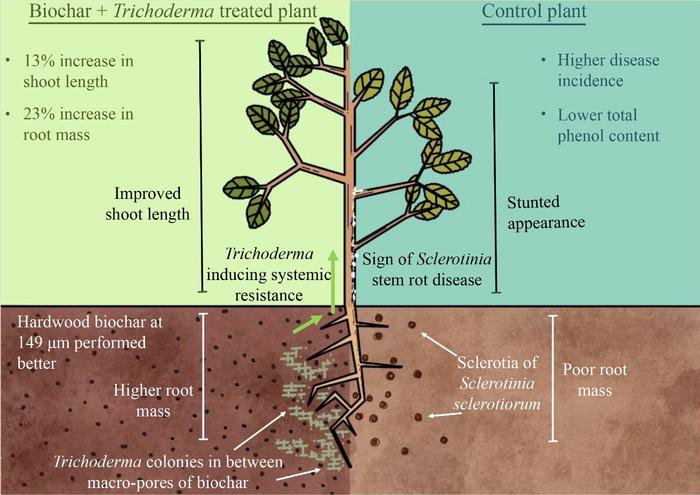
In the vast agricultural landscapes of India, chickpeas, scientifically known as Cicer arietinum, hold an irreplaceable place, acting as a cornerstone protein source for the predominantly vegetarian population. Remarkably, India contributes around 70% of the global chickpea production. This achievement is a result of sustained technological advancements in agriculture combined with robust national policies such as the national food security program. Between 2014 and 2022, India’s chickpea production nearly doubled, soaring from 7.3 million tons to an impressive 14 million tons. Nonetheless, this significant growth is imperiled by a devastating disease caused by the fungal pathogen Sclerotinia sclerotiorum, commonly known as white mold. This pathogen, thriving under specific temperature and humidity ranges, can slash chickpea yields by over 50%, making it a formidable threat to food security.
The resilience of Sclerotinia sclerotiorum largely stems from its ability to produce sclerotia—hardened masses that persist in soil for extended periods, ensuring the pathogen’s survival in adverse conditions. This biologically resilient persistence renders conventional management techniques, such as crop rotation and chemical fungicides, largely ineffective or unsustainable in the long term. Farmers often resort to intensive pesticide use to combat white mold, contributing to environmental hazards and escalating production costs. This predicament has spurred researchers worldwide to explore innovative, eco-friendly strategies to curb the pathogen’s impact without compromising crop health or soil ecology.
Biochar, a carbon-rich material derived from the pyrolysis of organic biomass in oxygen-limited environments, has emerged as a promising player in sustainable agriculture. Its porous architecture and high surface area establish an ideal habitat for beneficial microorganisms, providing shelter and a reservoir of carbon-based energy sources. This opens an avenue to leverage biochar not just as a soil amendment but as a carrier vehicle for biocontrol agents. Among such agents, Trichoderma species stand out for their multifaceted role: antagonizing pathogenic fungi through competition for nutrients and secretion of antimicrobial compounds, and simultaneously promoting plant growth by stimulating root development and enhancing nutrient uptake.
.adsslot_WY7LJojm8B{width:728px !important;height:90px !important;}
@media(max-width:1199px){ .adsslot_WY7LJojm8B{width:468px !important;height:60px !important;}
}
@media(max-width:767px){ .adsslot_WY7LJojm8B{width:320px !important;height:50px !important;}
}
ADVERTISEMENT
A groundbreaking study published in Frontiers of Agricultural Science and Engineering delves into the potential synergy between biochar and Trichoderma in tackling the persistent white mold problem in chickpeas. Spearheaded by researchers Vipul Kumar from Lovely Professional University, India, and Rachid Lahlali from the National School of Agriculture of Meknès, Morocco, this investigation set out to systematically analyze the effectiveness of different biochar types as carriers for Trichoderma and their subsequent impact on inhibiting Sclerotinia sclerotiorum. The research aimed to delineate the optimal biochar properties that could maximize Trichoderma colonization and pathogen suppression while simultaneously fostering chickpea growth.
Three biomass sources—hardwood, kitchen waste, and wheat straw—were selected for biochar production. These choices allowed a comparative assessment based on inherent physicochemical differences, including carbon-nitrogen ratios, lignin and cellulose content, as well as pore size distribution and surface morphology. These properties are critical because they dictate how effectively Trichoderma can colonize the biochar and survive in the soil environment. Samples produced were then subjected to rigorous laboratory testing where Trichoderma growth, density, and inhibitory interactions with Sclerotinia sclerotiorum were quantified across varying biochar concentrations and particle sizes.
Results from these experiments highlighted hardwood-derived biochar as the superior medium. Its elevated lignin and cellulose levels conferred greater structural stability and a more intricate pore network. After six weeks, hardwood biochar hosted Trichoderma populations reaching 3.35 million colony-forming units per gram, significantly surpassing the other biochar types. The researchers attribute this enhanced colonization capacity to the biochar’s porosity and chemical composition, which together provide an optimal microenvironment and nutrient availability for Trichoderma proliferation. Moreover, hardwood biochar’s characteristics inherently possess antifungal properties, given its slight alkalinity and physical barrier effects.
More strikingly, the consortium of hardwood biochar and Trichoderma demonstrated a potent “dual effect.” This synergy not only suppressed Sclerotinia sclerotiorum growth but also substantially promoted chickpea root system development. Field trials corroborated laboratory findings, showing a reduction in disease manifestation by 36.5%, a significant margin that holds enormous agronomic implications. Improved root architecture enhances water and nutrient absorption, boosting overall plant resilience and yield potential. This dual benefit suggests that integrating hardwood biochar with Trichoderma inoculants can act as an effective, environmentally benign alternative to chemical fungicides, addressing both disease management and crop productivity enhancement.
The underlying mechanisms enabling this dual function are multifaceted. The porous matrix of biochar acts as a “livable community” for Trichoderma, facilitating microbial colonization and activity. The carbon-rich biochar serves as a steady energy source, fostering sustained adversarial pressure against the pathogen. Additionally, the alkalinity of hardwood biochar creates an unfavorable environment for Sclerotinia sclerotiorum, directly inhibiting its survival. Complementarily, Trichoderma secretes enzymes and metabolites that degrade fungal cell walls and compete competitively for ecological niches. Furthermore, increased phenolic compound accumulation detected in chickpea leaves from treated plots indicates that this approach also stimulates endogenous plant defense mechanisms, reinforcing systemic resistance against white mold.
The study meticulously determined the optimal application parameters to maximize efficacy: a 4% biochar addition rate by weight and a particle size of approximately 150 micrometers. These precise specifications ensure adequate biochar surface area for microbial activity while maintaining desirable soil physical properties such as aeration and water retention. Such tuning is essential to avoid adverse effects that overly high biochar concentrations might cause, such as nutrient immobilization or altered soil pH beyond plant tolerance thresholds. Hence, this research not only provides a conceptual validation for the biochar-Trichoderma combination but also delivers practical guidelines for real-world agricultural deployment.
Adoption of this biochar-based biocontrol system aligns closely with global trends advocating sustainable agriculture and reduced chemical pesticide reliance. Chickpeas, vital for nutrition security in India and beyond, stand to benefit immensely from such integrated disease management approaches. The potential scalability of this technology is promising given the abundance of agricultural residues available for biochar production, particularly hardwood biomass, and the well-established cultivation methodologies for Trichoderma. The ecological advantages—improved soil health, reduced environmental contamination, and enhanced biodiversity—further underscore the transformative potential of this intervention.
Overall, the integration of biochar as a specialized carrier for biocontrol fungi not only targets pathogen suppression but simultaneously promotes crop vigour, signaling a paradigm shift in plant disease management strategies. This innovative approach embodies an intersection of microbiology, soil science, and agronomy, harnessing natural processes to meet the escalating demands of feeding a growing global population. Future research avenues may explore the longevity of such biocontrol effects across multiple crop cycles, field heterogeneity impacts, and the economic feasibility of large-scale biochar-Trichoderma applications.
In summary, the study by Kumar and Lahlali delineates a scientifically robust and practically viable methodology to counteract the pervasive threat of white mold in chickpeas. Using hardwood biochar as a carrier enriches the survival and efficacy of Trichoderma, achieving a remarkable reduction in disease severity while enhancing crop growth parameters. This dual-action biocontrol strategy promises to mitigate losses, reduce chemical inputs, and contribute to more sustainable agricultural practices—an urgent need amidst rising environmental challenges and global food security concerns.
Subject of Research: Not applicable
Article Title: Evaluation of biochar as a Trichoderma carrier for managing Sclerotinia sclerotiorum in chickpea
News Publication Date: 6-May-2025
Web References: http://dx.doi.org/10.15302/J-FASE-2024598
Image Credits: Prashant PAVEEN1, Vipul KUMAR1,‡, Prahlad MASURKAR1, Devendra KUMAR1, Amine ASSOUGUEM2, Chandra Mohan MEHTA1, Rachid LAHLALI2,‡
Keywords: Agriculture
Tags: agricultural advancements in Indiabiochar application in agricultureboosting chickpea production sustainablychickpea disease resistance strategiesenhancing crop resilience with biocharenvironmental effects of pesticide useimpact of white mold on chickpea yieldintegrated pest management for legumesorganic farming solutions for chickpeasSclerotinia sclerotiorum managementsustainable agriculture practicesTrichoderma as a biocontrol agent



